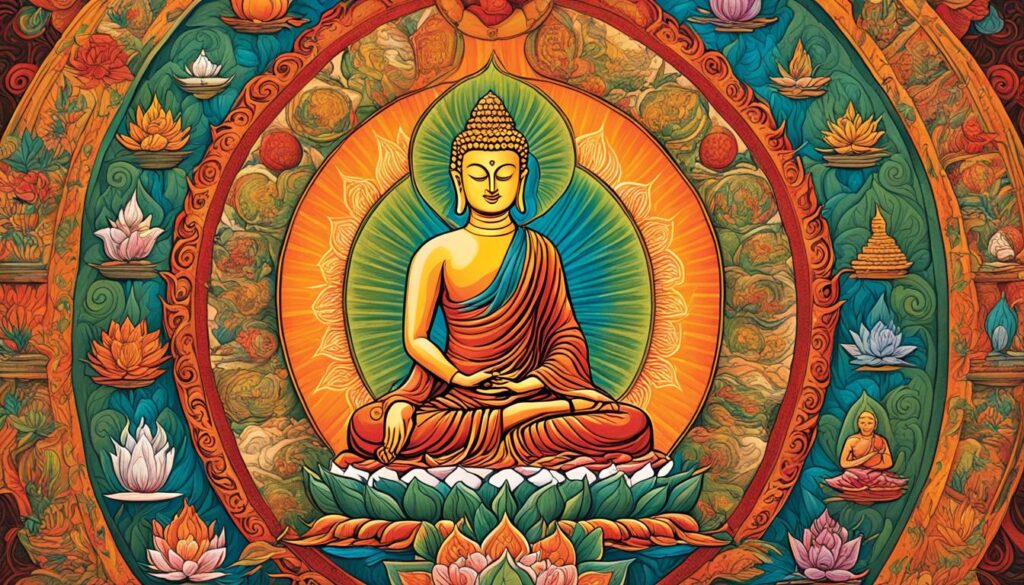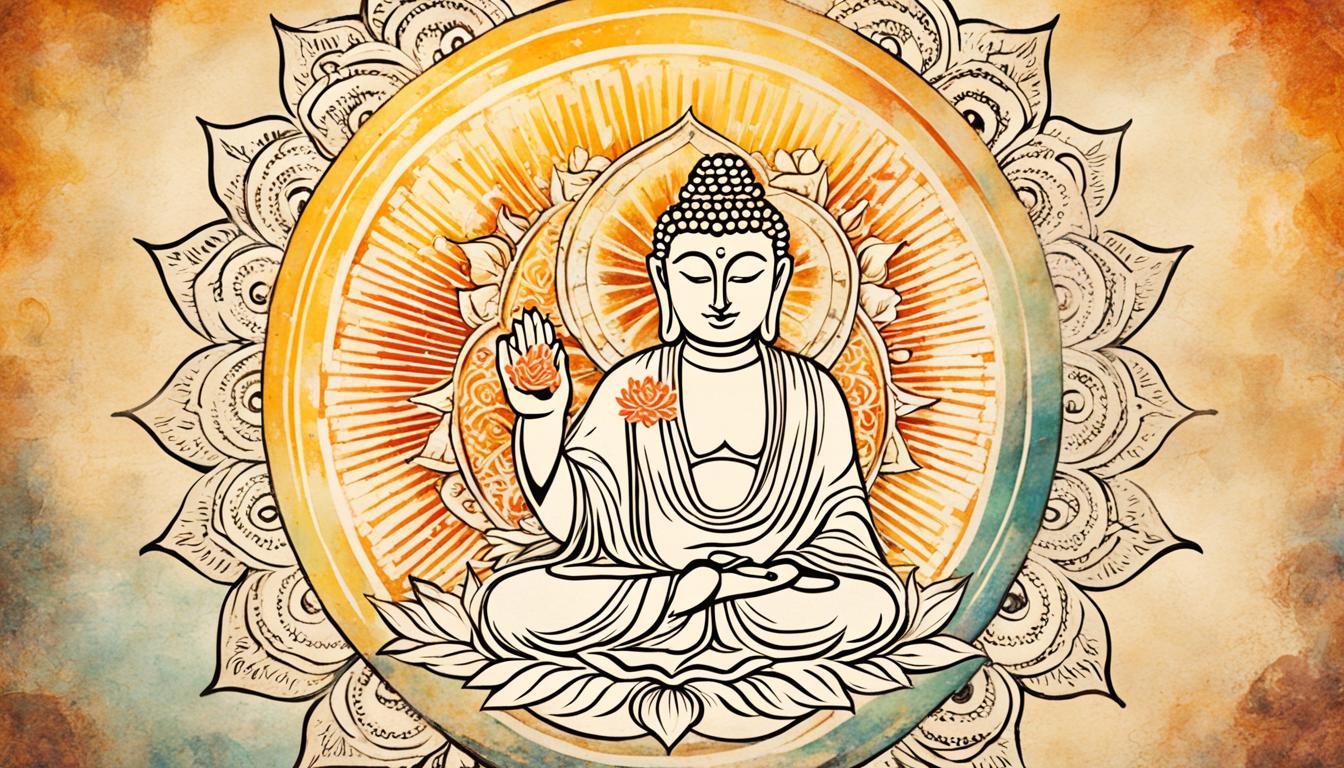“Thousands of candles can be lit from a single candle, and the life of the candle will not be shortened. Happiness never decreases by being shared.” – Buddha
Buddhism is a profound philosophy that offers valuable insights into life, suffering, and the pursuit of happiness. It is a path that encourages individuals to seek wisdom and cultivate compassion. In this article, we will delve into the central teachings of Buddhism, uncovering the core beliefs and principles that guide its followers.
Key Takeaways:
- The Four Noble Truths reveal the nature of suffering and provide a framework for understanding the human experience.
- Karma emphasizes the consequences of our actions and the importance of acting with mindfulness.
- The quest for Nirvana symbolizes liberation from the cycle of birth and rebirth, offering the ultimate goal of Buddhist practice.
- Embracing impermanence and the illusion of self challenges attachments and fosters a deeper understanding of reality.
- The practice of loving-kindness and the cultivation of mindfulness are essential tools for personal growth and spiritual development.
The Foundation: Three Fundamental Beliefs
At the very core of Buddhism lie three fundamental beliefs that guide its teachings and principles. These beliefs are the bedrock upon which the philosophy of Buddhism is built, shaping the understanding of the human experience and offering insights into the nature of suffering and liberation from its grasp.
The Four Noble Truths:
- Presented by Siddhartha Gautama, the Four Noble Truths encapsulate the essence of the human condition and form the foundation of Buddhism.
- These profound truths are not abstract concepts, but rather profound observations of reality and the nature of existence.
- By awakening to these truths, individuals can gain deep insight into the causes of suffering and its potential transcendence.
Karma:
- Karma is a central concept in Buddhism that teaches the principle of cause and effect.
- It emphasizes that every action, whether physical, verbal, or mental, has consequences.
- Understanding and embracing the law of karma empowers individuals to be mindful of their actions, encouraging them to cultivate virtuous behaviors and break free from negative cycles.
Quest for Nirvana:
- Nirvana symbolizes the ultimate goal of Buddhism: liberation from the cycle of birth and rebirth.
- It represents the state of pure enlightenment and freedom from suffering.
- The profound spiritual journey towards Nirvana inspires individuals to seek awakening, liberation, and inner peace.
These three fundamental beliefs form the solid foundation upon which Buddhism rests, providing a framework for understanding life, taking responsibility for one’s actions, and pursuing liberation from suffering. They serve as guiding principles and cornerstones for the journey towards enlightenment and ultimate serenity.
The Summit: Five Central Beliefs
Buddhism embraces five central beliefs that form the bedrock of its philosophy. By understanding and embodying these principles, practitioners can cultivate profound wisdom and transform their lives.
1. Embracing Impermanence
Impermanence: Central to Buddhism is the recognition that all things, including our own existence, are constantly changing. By accepting the ever-shifting nature of reality, Buddhists find freedom from attachment and suffering. This belief invites us to let go of our preconceived notions of permanence and embrace the beauty of each passing moment.
2. Challenging the Illusion of Self
The Illusion of Self: In Buddhism, the concept of a fixed and separate self is considered an illusion. Through meditation and self-reflection, practitioners come to realize that our sense of self is fluid and interconnected with all beings. This understanding liberates us from the ego’s grasping and allows us to cultivate a deep sense of compassion and interconnectedness.
3. Radiating Compassion
Radiating Compassion: Compassion lies at the heart of Buddhist belief. By recognizing the inherent worth and suffering of all beings, practitioners strive to cultivate love, kindness, and empathy. This compassionate attitude extends not only to fellow humans but also to animals and the entire natural world. It is through this foundation of compassion that genuine transformation and social harmony can flourish.
4. Advocating the Middle Way
The Middle Way: Buddhism emphasizes finding balance and moderation. Avoiding extremes and embracing the middle path leads to harmony and avoids the pitfalls of excess or deprivation. By walking the middle way, practitioners navigate life’s challenges with wisdom and equanimity, achieving a state of genuine well-being.
5. Cultivating Mindfulness
The Power of Mindfulness: Through the practice of mindfulness, Buddhists cultivate a deep awareness and acceptance of the present moment. By training the mind to be fully present, practitioners develop clarity, insight, and compassion. Mindfulness is often honed through meditation, allowing individuals to gain profound insights into the nature of reality and their own inner experiences.

| Belief | Description |
|---|---|
| Embracing Impermanence | Accepting the ever-changing nature of all things and finding freedom from attachment. |
| Challenging the Illusion of Self | Recognizing the fluid and interconnected nature of the self, leading to compassion and interconnectedness. |
| Radiating Compassion | Cultivating love, kindness, and empathy for all beings. |
| Advocating the Middle Way | Finding balance and moderation to avoid extremes and achieve genuine well-being. |
| Cultivating Mindfulness | Developing deep awareness, acceptance, and insight into the present moment and the nature of reality. |
The Essence: Ten Core Tenets
The essence of Buddhism is rooted in ten fundamental beliefs, each offering profound insights into the nature of existence and the path to liberation from suffering.
Recognizing the Universality of Suffering (Dukkha)
Suffering is an inherent part of human existence, experienced in various forms such as physical pain, loss, and dissatisfaction. By acknowledging the universality of suffering, Buddhists gain clarity on the fundamental challenges of life.
Suffering Arises from Attachment and Desire (Samudaya)
Suffering is not random or arbitrary. It originates from our attachment to worldly desires and the insatiable craving for pleasure, possessions, and power. Understanding the root cause of suffering enables individuals to navigate life with wisdom and detachment.
Realizing Liberation from Suffering is Attainable (Nirodha)
Buddhism teaches that liberation from suffering is not only possible but within reach for anyone who diligently follows the path. By cultivating mindfulness, compassion, and wisdom, individuals can gradually free themselves from the chains of suffering.
Following the Eightfold Path to Achieve Liberation (Magga)
The Eightfold Path serves as a comprehensive guide for Buddhists to attain liberation from suffering and achieve enlightenment. It consists of eight interrelated practices: Right View, Right Intention, Right Speech, Right Action, Right Livelihood, Right Effort, Right Mindfulness, and Right Concentration. Each aspect of the path helps individuals develop moral and ethical behavior, mental clarity, and profound insight.
Belief in Karma
Karma is a central concept in Buddhism, emphasizing the connection between actions and their consequences. According to this doctrine, every intention, thought, and action has repercussions that determine the course of future lives. Understanding karma empowers individuals to cultivate positive actions and intentions, leading to a more favorable future.
The Cycle of Birth and Rebirth (Samsara)
Reincarnation, or the cycle of birth and rebirth, is a fundamental aspect of Buddhist philosophy. It suggests that consciousness continues to exist after death and takes on new forms in subsequent lives. By comprehending the cycle of Samsara, Buddhists strive to break free from its perpetual nature through enlightenment and liberation.
The Impermanence of All Things (Anicca)
Impermanence is an undeniable truth of existence. Nothing in the universe, including life itself, is permanent or unchanging. Recognizing the impermanence of all things encourages Buddhists to find peace and contentment in the present moment rather than clinging to transient pleasures.
The Illusion of Self (Anatta)
The concept of Anatta challenges the notion of a fixed and independent self. Buddhism teaches that there is no permanent, unchanging essence or soul that defines an individual. The illusion of self liberates individuals from attachment to ego and fosters a deeper understanding of interconnectedness and interdependence.
The Practice of Loving-Kindness (Metta)
Buddhism encourages the cultivation of loving-kindness, a boundless and unconditional love and compassion for all beings. Metta practice promotes harmony, empathy, and the well-being of oneself and others, fostering a sense of interconnectedness and reducing conflict.
The Ultimate Goal: Nirvana, Liberation from Suffering
Nirvana represents the ultimate goal of Buddhist practice: the liberation from suffering and the attainment of enlightenment. By transcending the cycle of birth and death, individuals achieve a state of complete freedom, inner peace, and ultimate bliss.

| Tenet | Description |
|---|---|
| Recognizing the Universality of Suffering (Dukkha) | Suffering is an inherent part of human existence, experienced in various forms such as physical pain, loss, and dissatisfaction. |
| Suffering Arises from Attachment and Desire (Samudaya) | Suffering originates from attachment to worldly desires and the insatiable craving for pleasure, possessions, and power. |
| Realizing Liberation from Suffering is Attainable (Nirodha) | Liberation from suffering is not only possible but within reach for anyone who diligently follows the path. |
| Following the Eightfold Path to Achieve Liberation (Magga) | The Eightfold Path serves as a comprehensive guide for Buddhists to attain liberation from suffering and achieve enlightenment. |
| Belief in Karma | Karma emphasizes the connection between actions and their consequences, shaping the course of future lives. |
| The Cycle of Birth and Rebirth (Samsara) | Samsara represents the cycle of birth and rebirth, with consciousness taking on new forms in subsequent lives. |
| The Impermanence of All Things (Anicca) | Impermanence is an undeniable truth, reminding us that nothing in the universe is permanent or unchanging. |
| The Illusion of Self (Anatta) | Anatta challenges the notion of a fixed and independent self, encouraging deep understanding of interconnectedness. |
| The Practice of Loving-Kindness (Metta) | Cultivating boundless love and compassion for all beings fosters harmony, empathy, and overall well-being. |
| The Ultimate Goal: Nirvana, Liberation from Suffering | Nirvana represents the ultimate goal of liberation from suffering and the attainment of enlightenment. |
The Core Essence: Four Pillars of Buddhism
Buddhism’s essence rests on four pillars. These pillars embody the core beliefs and main teachings of Buddhism, guiding practitioners on their spiritual journey towards enlightenment.
The First Pillar: Dukkha – Recognizing the Inseparability of Suffering
The first pillar of Buddhism is an acknowledgment that suffering is an inherent part of existence. This concept, known as Dukkha, holds that all beings experience various forms of suffering throughout their lives. By understanding and accepting the inevitability of suffering, individuals can develop resilience and compassion, paving the way for personal growth.
The Second Pillar: Desires Unveiled – Rooted in Attachment and Desire
The second pillar of Buddhism teaches that suffering is rooted in attachment and desire. The pursuit of worldly desires creates an endless cycle of craving and dissatisfaction, perpetuating suffering. By recognizing the impermanence and transient nature of all things, individuals can cultivate detachment and find liberation from suffering.
The Third Pillar: Nirvana’s Call – Symbolizing Liberation from Suffering

The third pillar of Buddhism revolves around the concept of Nirvana. Nirvana represents the ultimate goal of Buddhism – liberation from suffering and the cycle of rebirth. It is a state of profound peace, wisdom, and enlightenment that can be achieved through spiritual practice and the eradication of desire and ignorance.
The Fourth Pillar: Path to Freedom – The Eightfold Path
The fourth pillar of Buddhism is the Eightfold Path, which serves as a guide to reach Nirvana. This path consists of eight interconnected principles: Right View, Right Intention, Right Speech, Right Action, Right Livelihood, Right Effort, Right Mindfulness, and Right Concentration. By following this path, individuals can cultivate moral discipline, mindfulness, and wisdom, eventually achieving liberation from suffering and attaining enlightenment.
Types of Buddhism
Today, Buddhism is practiced in various forms around the world. Three main types are prevalent: Theravada Buddhism, Mahayana Buddhism, and Tibetan Buddhism. Each type has its own specific geographical areas and slightly different interpretations of Buddha’s teachings.
1. Theravada Buddhism
Theravada Buddhism, also known as the “Way of the Elders,” is the oldest surviving form of Buddhism. It is primarily practiced in Southeast Asian countries such as Thailand, Sri Lanka, Cambodia, and Myanmar. Theravada Buddhists follow the teachings of the Pali Canon, a collection of scriptures believed to be the earliest recorded words of the Buddha.
2. Mahayana Buddhism
Mahayana Buddhism, also known as the “Great Vehicle,” is the most widely practiced form of Buddhism. It is prevalent in East Asian countries such as China, Japan, Korea, and Vietnam. Mahayana Buddhists believe in the concept of Bodhisattvas, enlightened beings who compassionately guide others towards enlightenment. They also emphasize the ideal of attaining Buddhahood for the benefit of all sentient beings.
3. Tibetan Buddhism
Tibetan Buddhism, also known as Vajrayana Buddhism, originated in Tibet and the Himalayan regions. It is characterized by its rich ritualistic practices and the use of esoteric techniques to attain enlightenment. Tibetan Buddhists follow the teachings of various lineages and place importance on the guidance of spiritual teachers, known as lamas.

In summary, these different forms of Buddhism showcase the universal appeal and adaptability of the Buddha’s teachings. While each type may have its unique practices and interpretations, they all share the common goal of helping individuals cultivate wisdom, compassion, and inner peace.
Conclusion
Immerse yourself in the profound teachings of Buddhism and embark on a transformative spiritual journey. By embracing the core beliefs of Buddhism, you gain invaluable insights into the nature of suffering and the pursuit of liberation. The Four Noble Truths provide a foundation for understanding suffering and its eradication.
Karma, the law of cause and effect, reminds us that our actions have consequences and shapes our present and future experiences. Compassion and mindfulness, essential principles of Buddhism, allow you to cultivate love, kindness, and deep awareness in your interactions with others and yourself.
Embrace the Middle Way, seeking balance and moderation in all aspects of life, steering clear of extremes. By incorporating the wisdom of Buddhism into your daily life, you foster personal growth and enhance your overall well-being. Journey along the Eightfold Path, following a path of morality, wisdom, and meditation, towards the ultimate goal of Nirvana—liberation from suffering, peace, and enlightenment.
FAQ
What are the core teachings of Buddhism?
The core teachings of Buddhism include the Four Noble Truths, karma, and the quest for Nirvana.
What are the three fundamental beliefs in Buddhism?
The three fundamental beliefs in Buddhism are the Four Noble Truths, karma, and the quest for Nirvana.
What are the five central beliefs in Buddhism?
The five central beliefs in Buddhism are embracing impermanence, the illusion of self, radiating compassion, following the Middle Way, and practicing mindfulness.
What are the ten core tenets of Buddhism?
The ten core tenets of Buddhism include recognizing suffering, understanding the origins of suffering, realizing that liberation from suffering is attainable, following the Eightfold Path, believing in karma, accepting the cycle of birth and rebirth, acknowledging the impermanence of all things, understanding the illusion of self, practicing loving-kindness, and striving for Nirvana.
What are the four pillars of Buddhism?
The four pillars of Buddhism are acknowledging suffering, understanding that suffering arises from attachment and desire, symbolizing liberation from suffering, and following the Eightfold Path.
What are the main types of Buddhism?
The main types of Buddhism are Theravada Buddhism, Mahayana Buddhism, and Tibetan Buddhism.
How can Buddhism enhance personal growth?
Buddhism offers valuable teachings on addressing suffering, finding peace, and fostering personal growth through principles such as compassion, mindfulness, and the Middle Way.

